What Is Microsoft Bing?
Bing is a search engine developed and operated by Microsoft. It offers a variety of search features, including web, image, and map searches. Along with advanced AI-driven search functionalities.
Beyond its core search capabilities, Bing is known for its user-friendly interface and integration with other Microsoft products and services, including Windows 11, Xbox, and Microsoft 365.
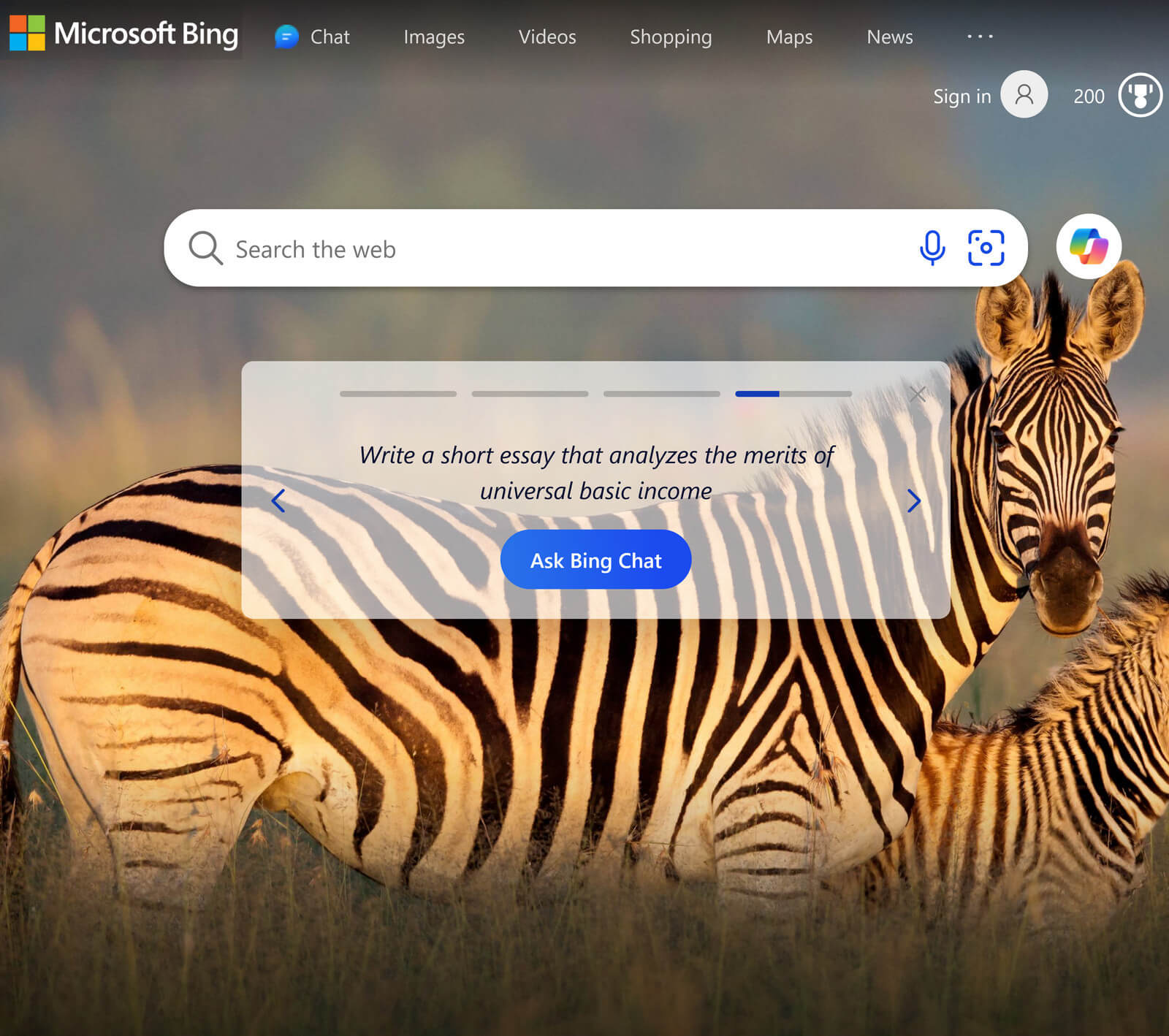
The Evolution of Bing Search
Here’s an overview of Bing’s history and its current standing in the search engine marketplace.
The Rise of Bing in the Search Engine Arena
At launch, Microsoft Bing search was touted as a “Decision Engine”—a more advanced search service built to help customers make better-informed decisions. Rather than just navigating the web and finding information.
As such, Bing came with several new features to provide users with more context for their search results.
These included the “Best Match” feature to highlight the most relevant responses to user queries, “Deep Links” for greater insight into each result, and “Web Groups” to organize results into more intuitive categories.
Here’s how Bing search has evolved over the years:
- June 2009: Microsoft launched Bing in June 2009 during a rebrand of its earlier Live Search and MSN Search search engines
- July 2009: Microsoft and Yahoo! struck a 10-year deal for Bing to power the Yahoo! search engine. This partnership aimed to give both companies the necessary scale and resources to compete in a Google-dominated market.
- February 2010: Microsoft partnered with Facebook to display Bing results for users searching within Facebook. And later that year, Bing started using Facebook data to enhance the personal relevance of its search results.
- July 2015: Microsoft’s 2015 launch of Windows 10 marked another significant milestone for Bing. The search engine was intricately woven into the new operating system, particularly through the Cortana voice-powered assistant.
- June 2017: Bing introduced visual search capabilities, enabling image-based web searches. This year also saw Bing surpass Yahoo! as the world’s second-largest search engine.
- February 2023: Microsoft addedBing Chat to Bing. Later rebranded as Copilot, this AI-powered chatbot lets search users get tailored, human-like responses to their questions with links to the original sources.
- March 2023: Bing reached 100 million active daily users for the first time
Overview of Bing's Current Market Position
Despite several advancements since its 2009 release, Bing has struggled to significantly challenge Google’s overwhelming global search engine market share, which has only once fallen below 90% in 2014.
As of January 2024, Bing held 3.40% of the global search engine market share across all devices. And while this may seem modest compared to Google’s 91.54% global market share, it still amounts to around 1.3 billion unique monthly visits worldwide.
The competition narrows more noticeably in the desktop segment. Bing captured 10.51% of the global desktop search engine market, while Google maintained an 81.94% market share. This smaller gap is likely due to Bing’s integration with Microsoft’s desktop devices.
The Bing search engine also claimed 7.20% of the North American search market—higher than its global average. The U.S. market played a significant role in this performance, accounting for roughly 26% of Bing’s total visits.
It’s important to note that Bing has recently made major strides in integrating AI technology into its services. As we’ll now see, these developments could significantly boost its ability to compete against Google.
Further reading: 21 Best Search Engines in the World
The Integration of AI in Bing Search
Mainstream search engines like Bing have long incorporated AI technology and machine learning techniques to improve the speed, accuracy, and convenience of their search services.
However, in 2023, Microsoft launched a new AI-powered version of Bing featuring an advanced digital assistant called Copilot (previously called Bing Chat). This new Bing ran on OpenAI’s GPT-4 large language model, customized for search.
Bing’s integration of generative AI technology marked a major step forward in AI-powered search.
You can now have human-like conversations with Bing AI to find the information you need, in addition to using the traditional Bing search format.
Bing’s Copilot assistant also allows you to perform various tasks, like summarizing text, creating images, and writing code.
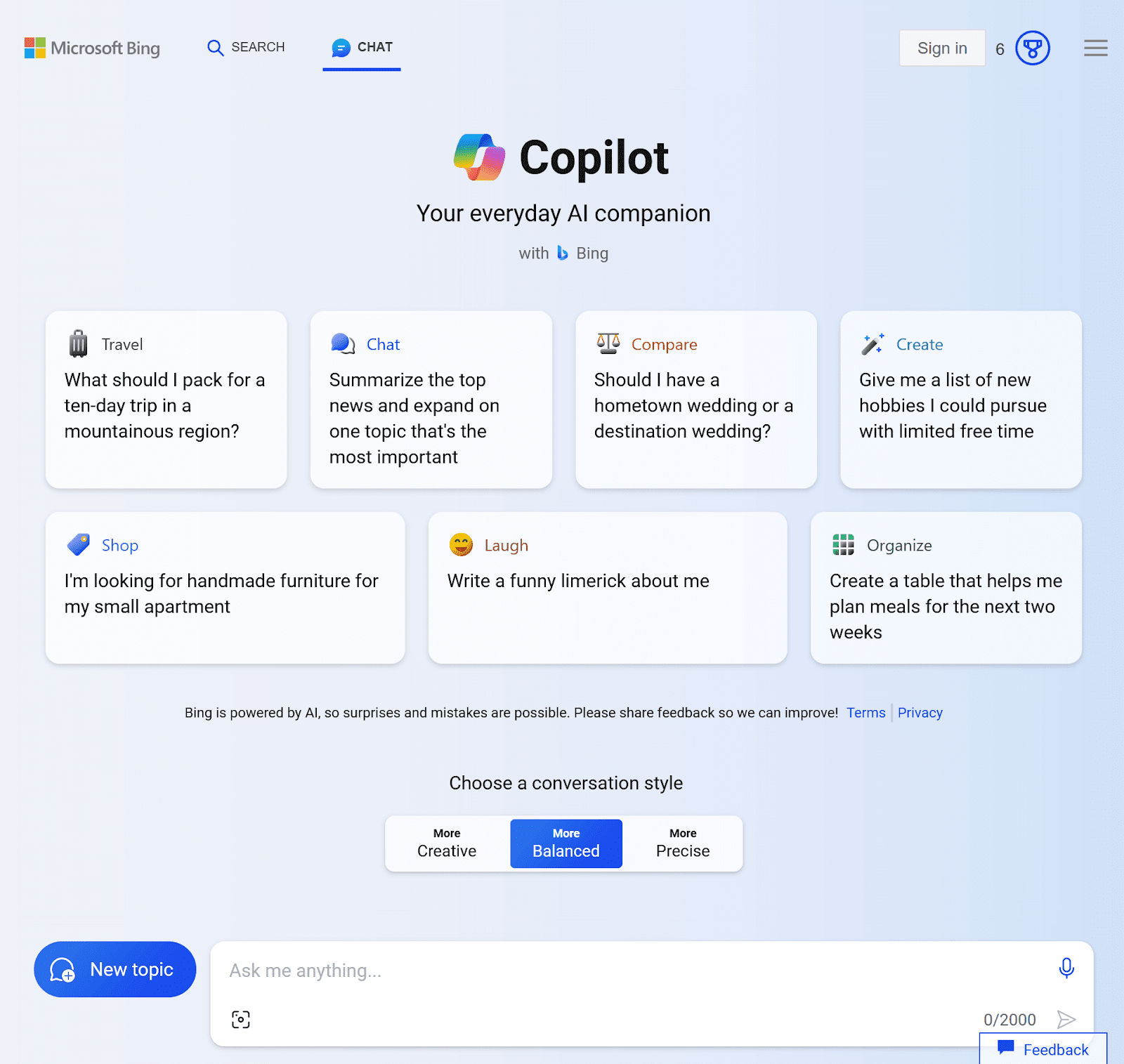
Bing AI Search Results Examples
The Bing homepage provides several ways to directly engage with the Copilot assistant.
Click the “Chat” button in the top-left corner, the Bing icon to the right of the search box, or the “Ask Bing Chat” option beneath the search box.
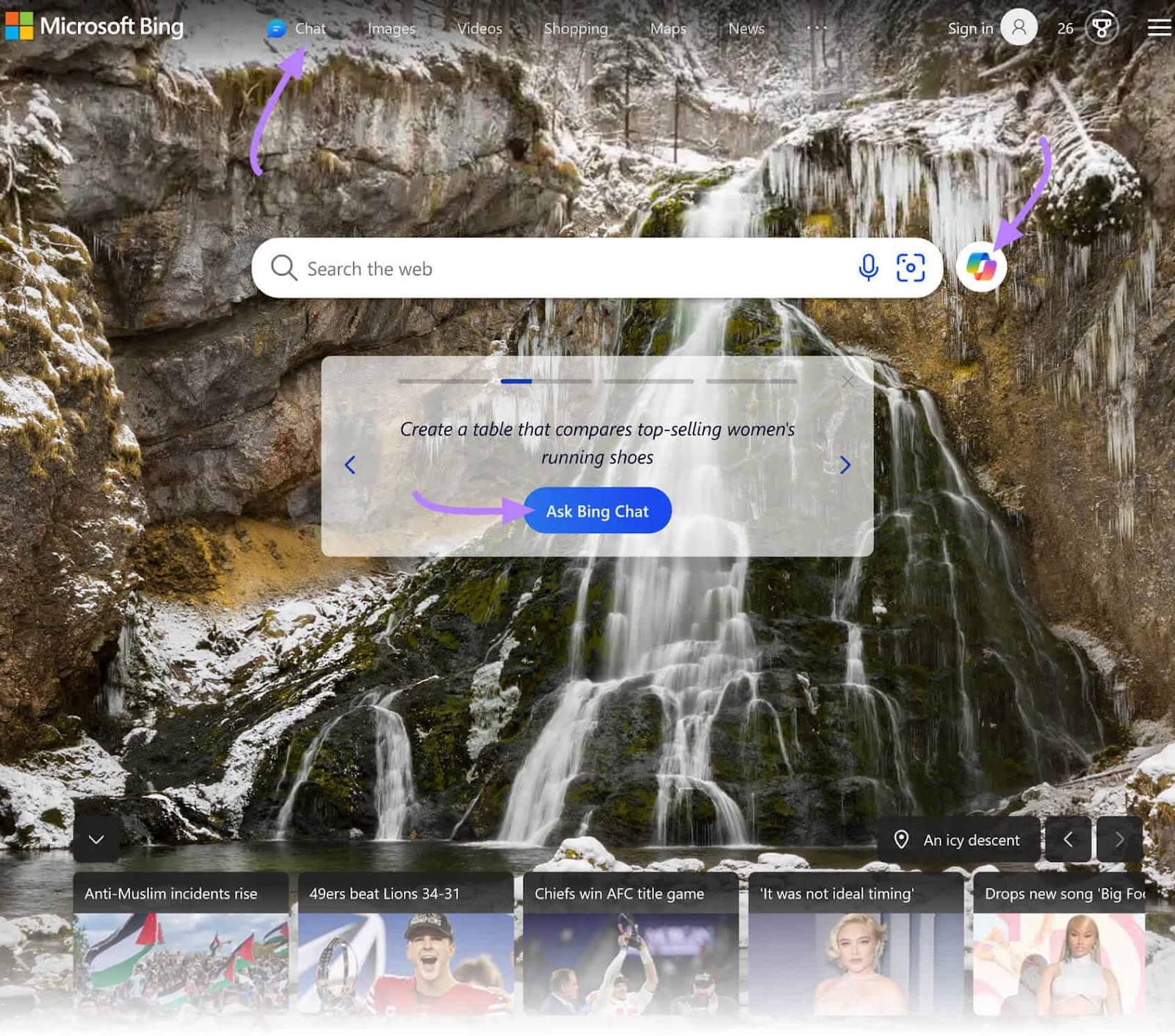
Once you enter a query into the search box, the results page will often include a chat window with an AI-generated answer.
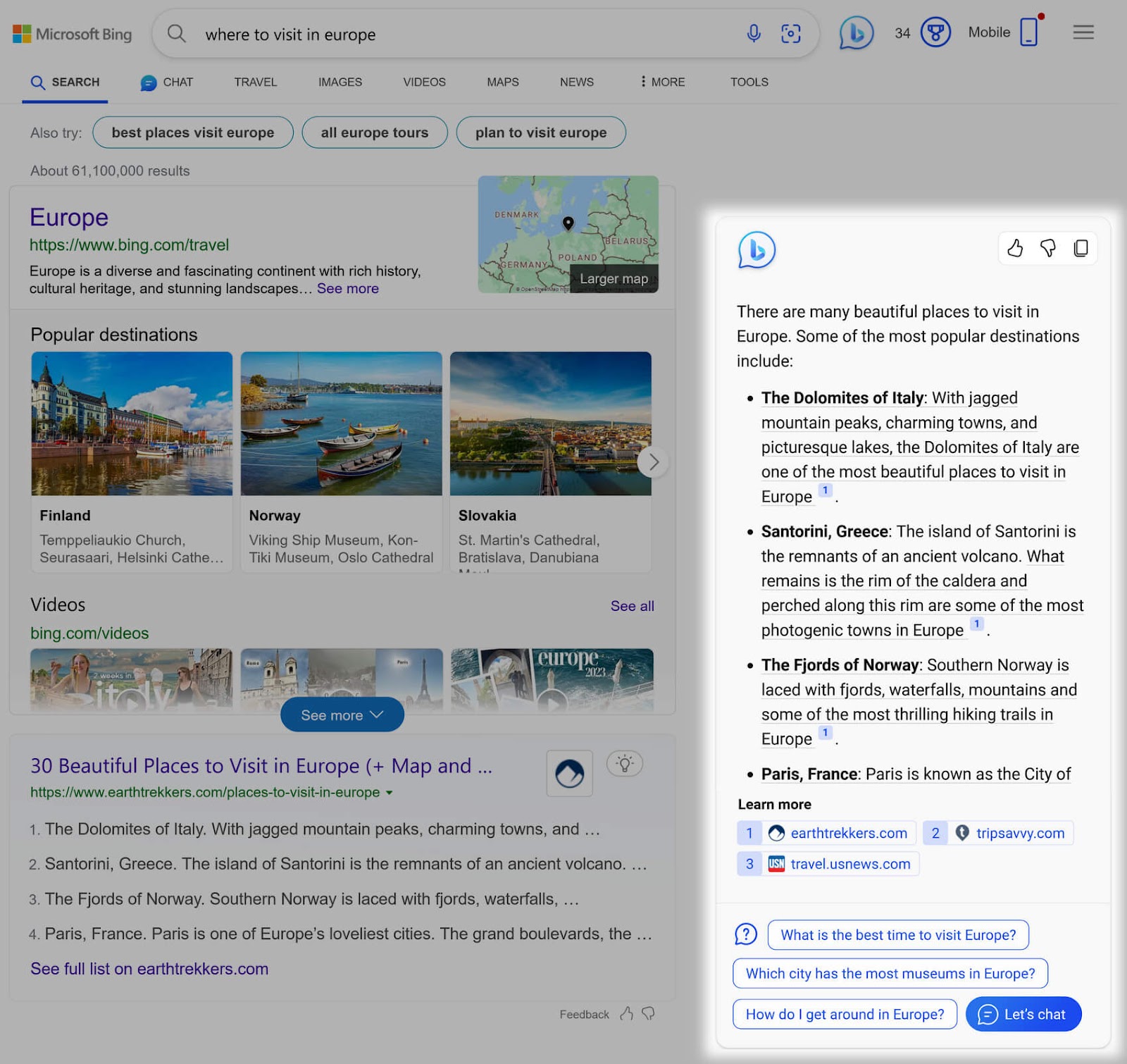
Once you interact with the chat option, Bing automatically displays the full Copilot window. Ask follow-up questions, with Copilot generating conversational answers featuring relevant, clickable sources from across the web.
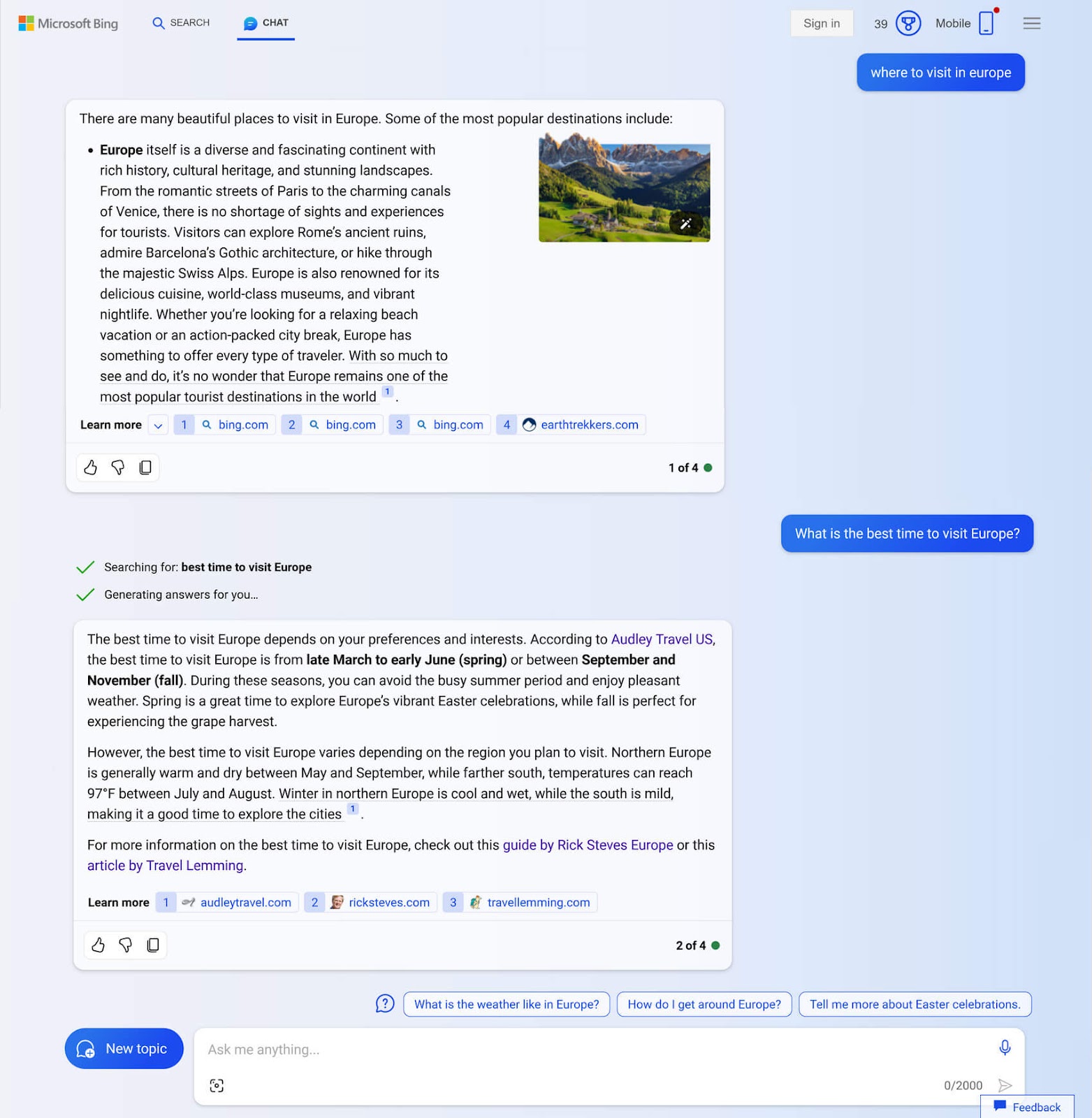
Bing has also enhanced its search experience with the introduction of AI-generated knowledge cards. These cards appear on the right-hand side of the results page, helping users explore topics with facts, image-based timelines, and related topics.
Here’s an example for the query “impressionism”:
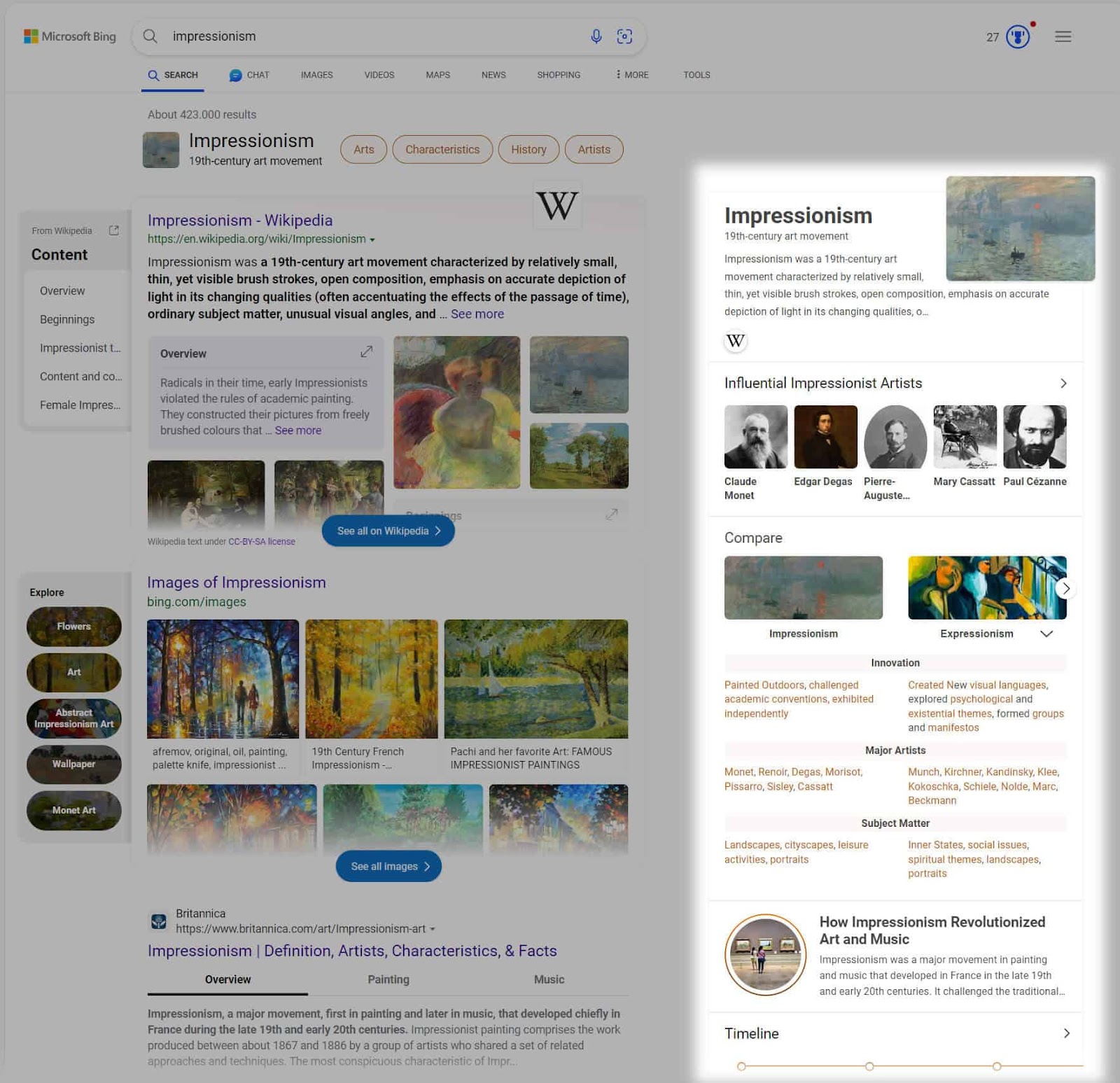
Exploring the Features of Bing Search
Beyond its unique AI capabilities, Bing offers several features and functionalities that distinguish it from other search engines.
- Homepage background image: Bing’s homepage features a high-quality background image that changes each day. This sets it apart from the more minimalist homepage designs of search engines like Google.
- Microsoft Rewards: Members of the Microsoft Rewards loyalty program can earn points just by searching with Bing. Users can then redeem these points for things like free gift cards, games, and movies.
- Integration with the Microsoft ecosystem: Bing seamlessly integrates with several Microsoft products and services, like Windows OS, the Edge browser, and Office
- Bing Maps: Bing Maps includes some unique features like Bird’s Eye View, providing high-resolution aerial imagery that resembles looking down from a low-flying aircraft

- Video previews: Bing’s video search function plays a preview of each video when users hover over the thumbnail, making it easier to find relevant content quickly
Navigating Bing's User Interface
Bing’s user interface strikes a difficult balance between simplicity and functionality.
Here are some key elements of its layout and design:
- Navigation: Bing’s homepage contains a simple top-level navigation bar with links to different search types, including chat, shopping, and Bing image search
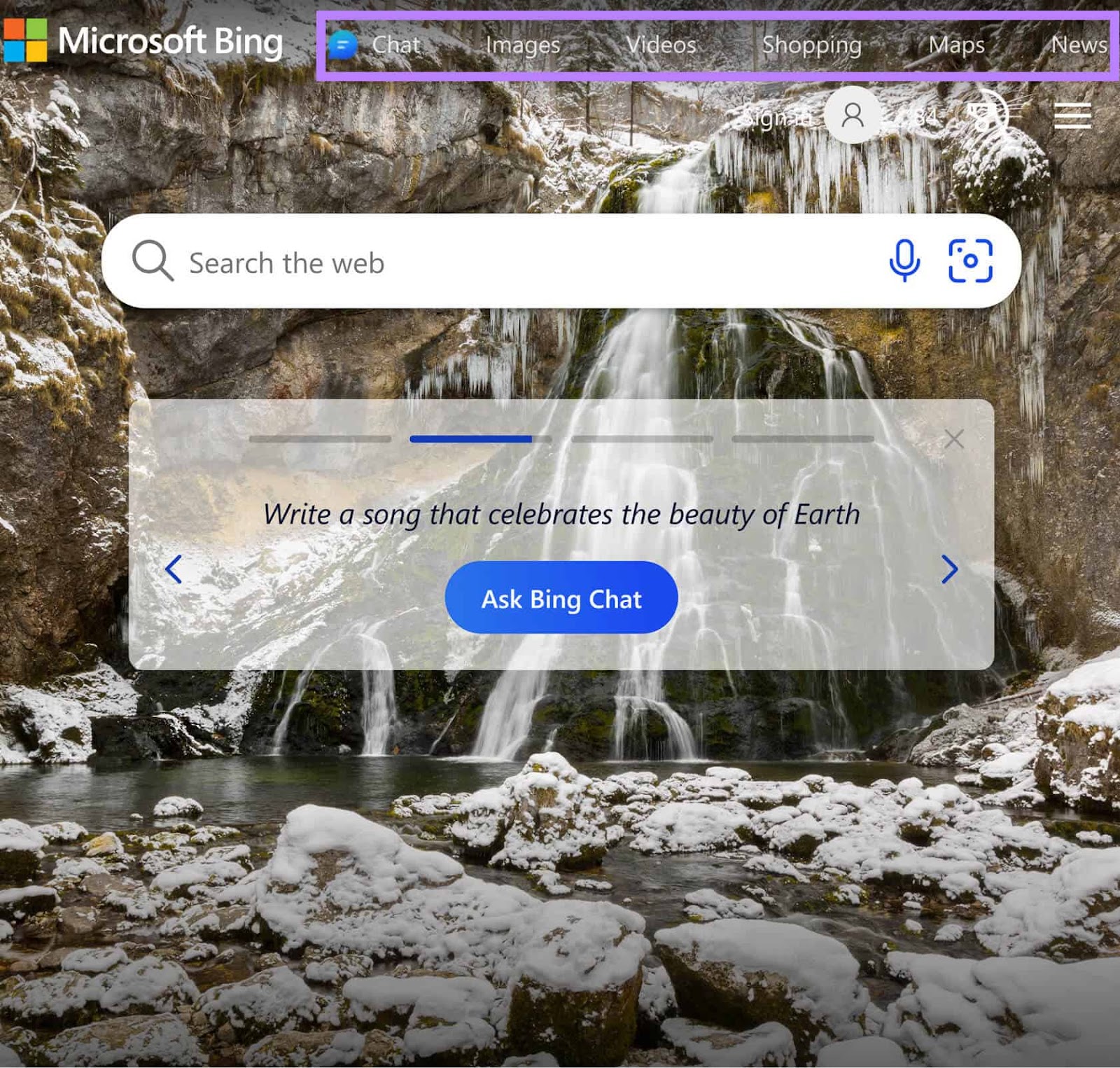
- Rich search results: Bing’s search results are often highly visual and offer several ways to preview content before clicking on any results. For example, hovering over a video result triggers a video preview, and Wikipedia results feature a table of contents allowing users to scroll through the page without clicking through.
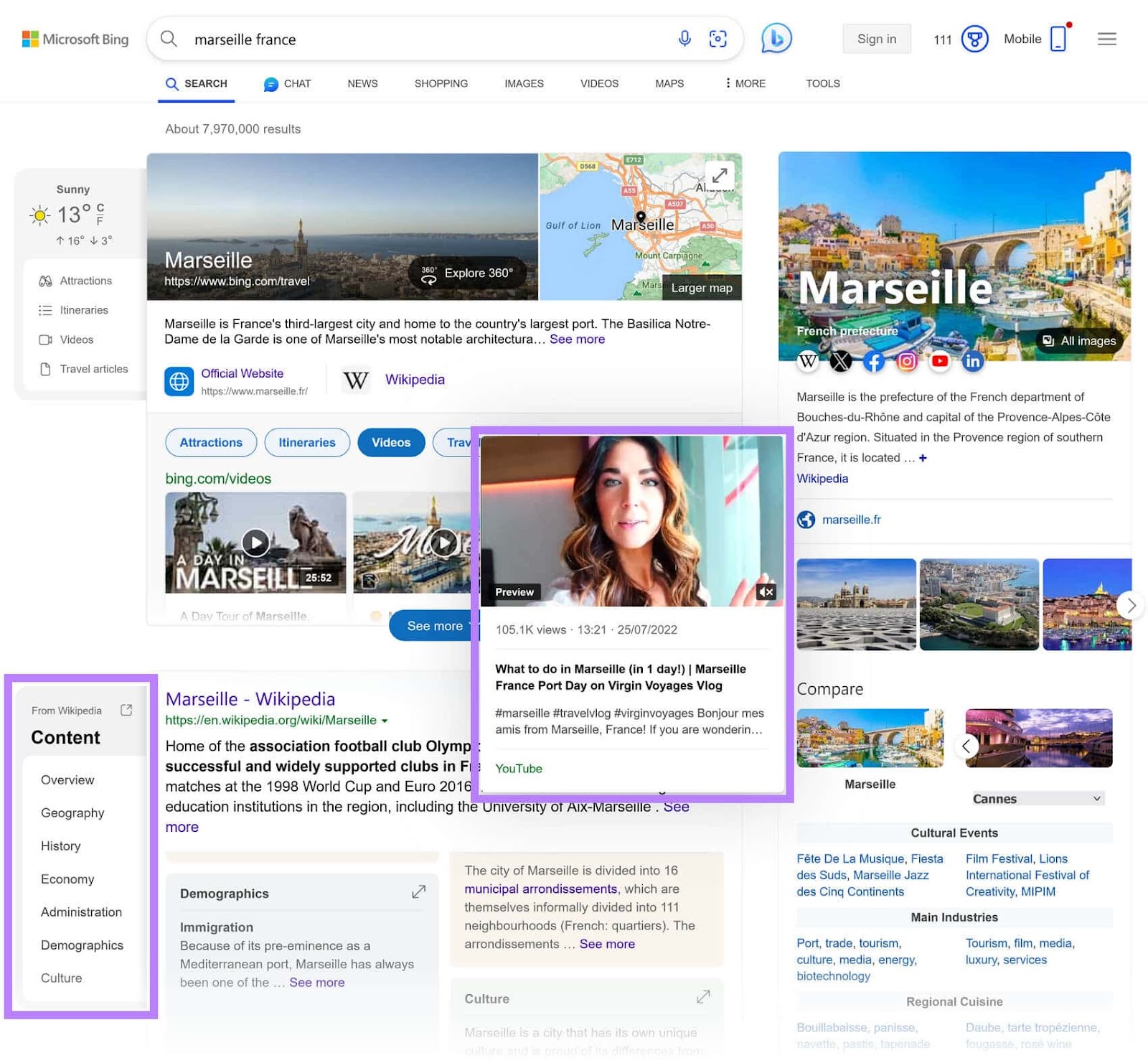
- Paid advertising: Bing displays paid listings throughout its search results, which carry the “Ads” label
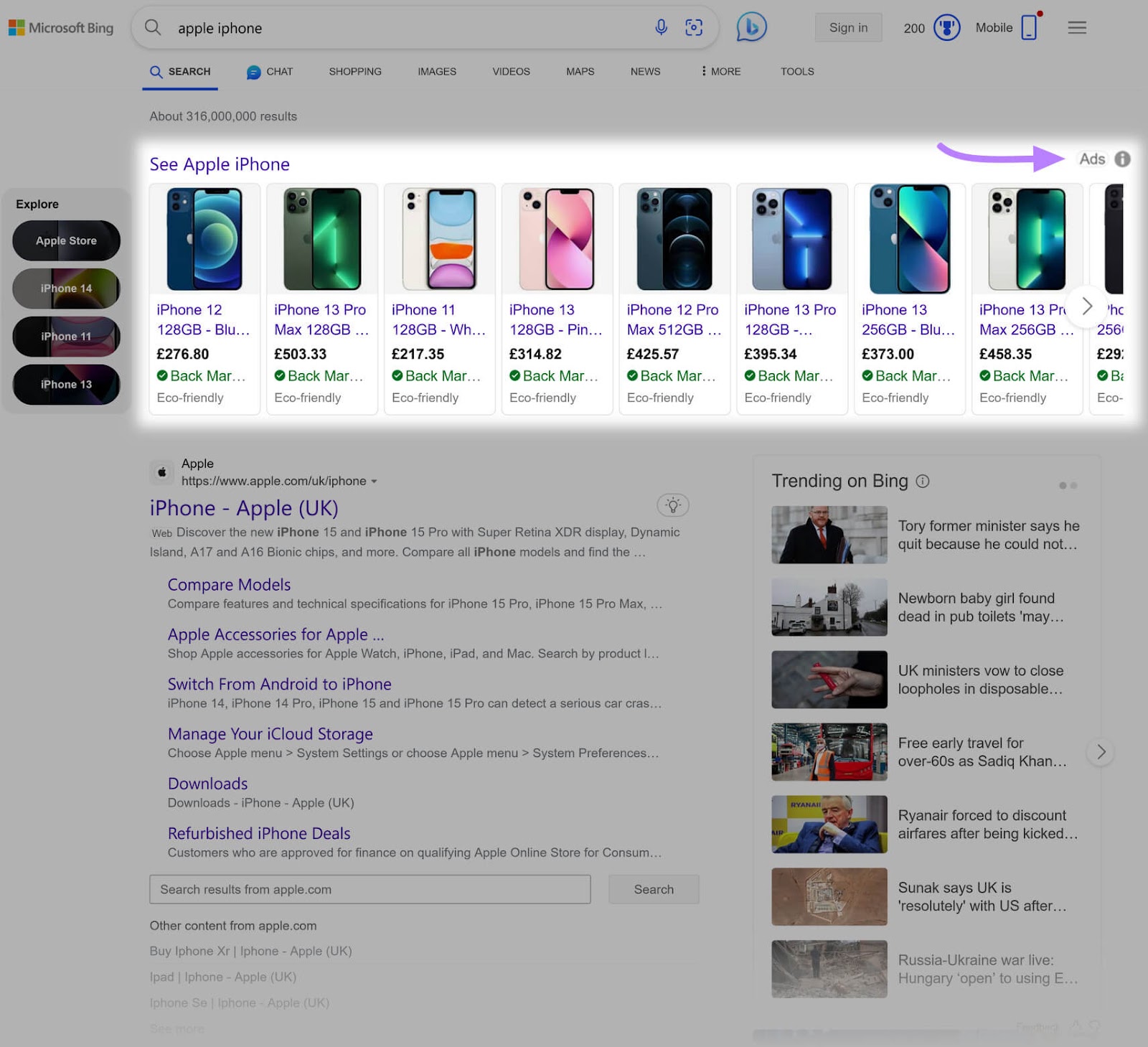
- Related searches: Bing provides users with other searches related to their query at the bottom (and sometimes at the side) of the results page. For example, if you search for “men’s slim fit jeans,” Bing will show related searches like “men’s slim cropped black jeans.”
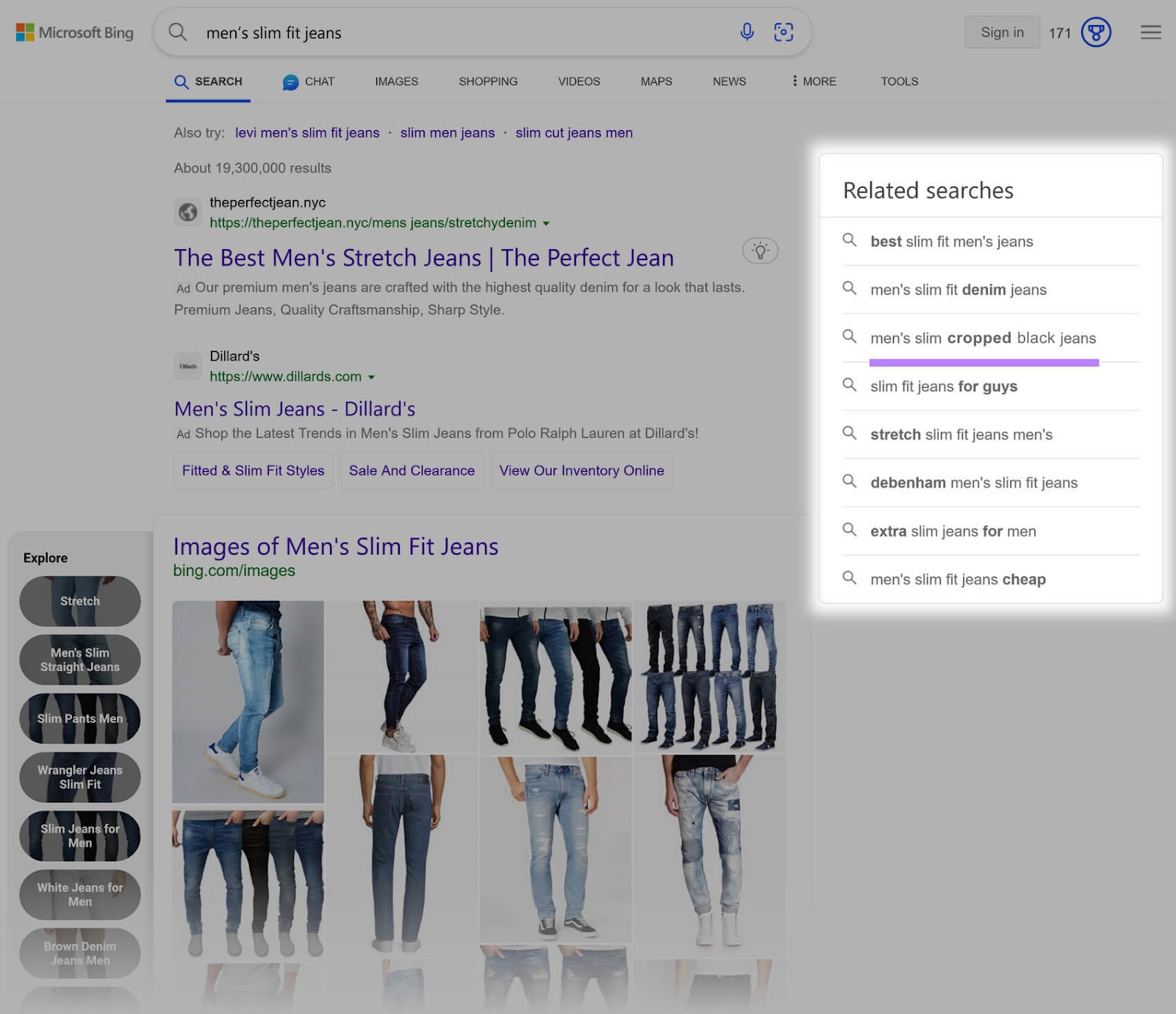
- Search icon: Bing lets users refine their search by clicking a permanent search icon rather than scrolling back to the top of the page. You’ll find this icon at the bottom right corner of the search screen.
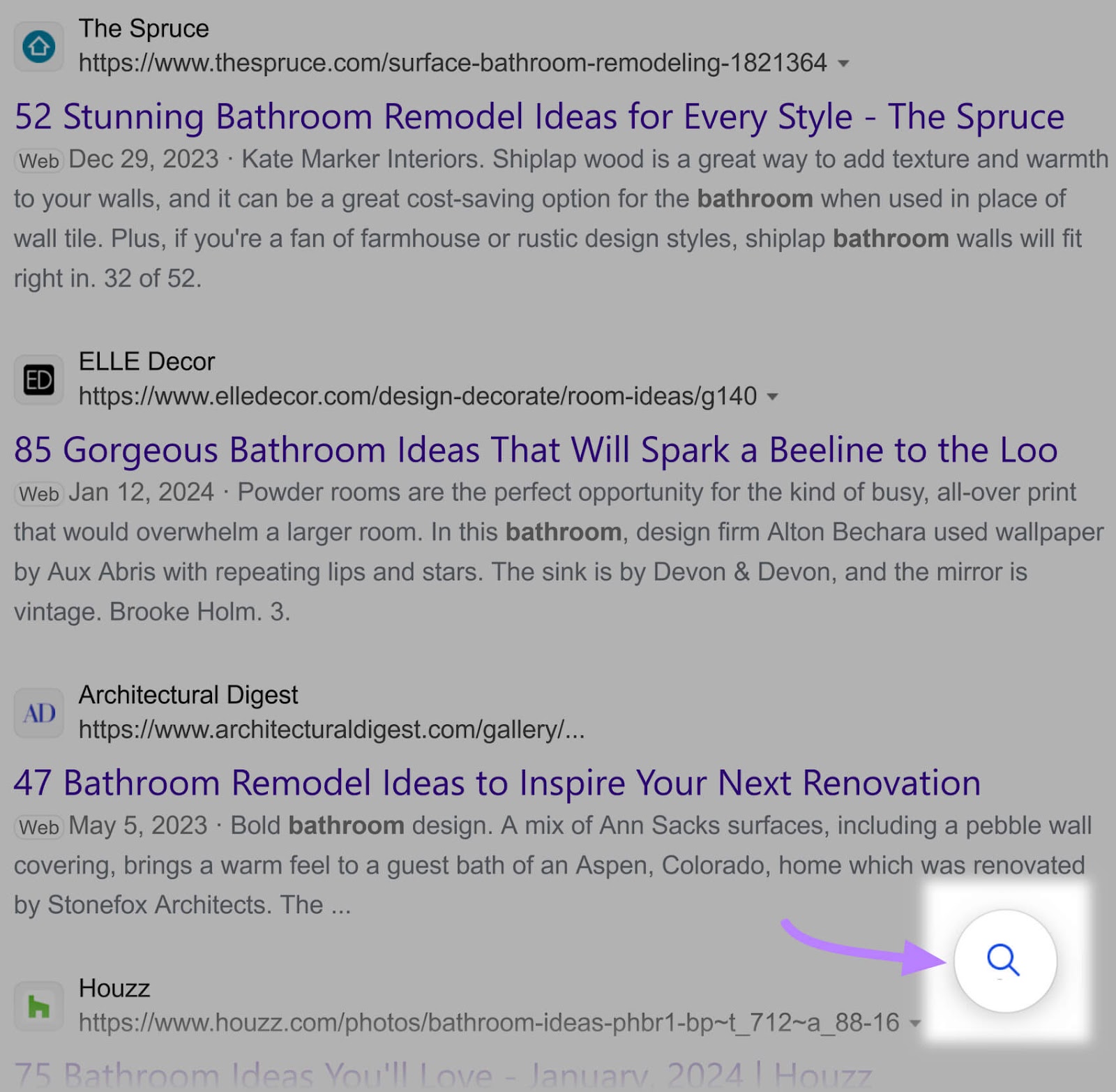
Advanced Search Options and Tools
Like other major search engines, Bing offers a range of advanced options to help users refine their searches and get more precise results.
Some of the main options include:
- Advanced search options: Bing supports various search options to help users narrow their results. These include using " " to find exact matches, NOT to exclude results containing a specific word or phrase, and OR to find pages containing either word or phrase.
- Search filters: Bing lets users refine their search by date, location, and language
- Image search: Bing’s image search lets users filter results by size, color, type (photo, GIF, transparent), and license type. Users can also upload an image to find similar images on the internet.
- Maps: Bing Maps provides detailed maps and local information, including directions, traffic, and business listings
- Bing Shopping: Bing’s shopping feature lets users search for products using filters like brand, price range, and color
- SafeSearch: Bing lets users filter adult content from their results, with options including strict, moderate, and off
Bing Search Ranking Factors
As with Google, specific details about Bing’s core search algorithm aren't publicly available. Keeping this information under wraps helps search engines prevent manipulation of their search results.
That said, the basic tenets of improving SEO rankings apply across all major search engines.
Also, Bing is relatively open about the high-level parameters it uses to determine rankings.
Here they are in general order of importance:
- Relevance: Content should reflect the user’s search intent, providing them with the information they seek. Bing looks for terms that match the user’s query both on the page and in links pointing to the page. It also factors in the presence of terms with the same or similar meaning.
- Quality and credibility: Content should be valuable, trustworthy, and original. Bing determines the authority of a website by considering what other sites link to it, how well it distinguishes fact from opinion, and whether they cite their sources.
- User engagement: Bing takes into account how users engage with different search results, like whether they clicked on a result and, if so, whether they quickly bounced back to Bing
- Freshness: Content should provide up-to-date information wherever possible
- Location and language: Bing considers the user’s location, the language of the page, and the location of other page visitors when ranking results
- Page speed: In many cases, Bing assumes that slow-loading pages provide a poor user experience
As with Google, Bing prohibits the use of deceptive practices to try to game its search rankings.
Attempts to gain an unfair advantage through methods like cloaking (hiding keywords), keyword stuffing (overloading content with keywords), or link spamming (adding multiple irrelevant links to content) can lead to significant penalties.
Comparing Bing and Google: SEO Differences
Despite many similarities between Bing and Google, a few key differences exist in how they rank and index websites.
Perhaps the biggest difference is Google’s mobile-first index. Pages that aren’t optimized for mobile devices are less likely to rank well in Google’s results, even for desktop searches. Bing, on the other hand, maintains a desktop-first index.
Another major difference relates to the importance of social signals. Bing has previously mentioned that it factors in social signals when ranking websites. More recent support for this comes from the fact that Bing’s Webmaster Guidelines advise against using social media schemes to game its algorithm.
Meanwhile, Google has flatly denied its ranking algorithm considers social signals.
A third difference is how both search engines analyze content. As we saw earlier, Bing places a significant emphasis on exact match keywords when determining the relevance of a piece of content for a particular query (although it also factors in semantic equivalents).
Google is more focused on understanding the intent and context surrounding user searches through other means.
This is especially evident in Google’s use of natural language processing algorithms like BERT (Bidirectional Encoder Representations from Transformers), which allows it to understand the nuances and relationships between words in a query.
Mastering Bing SEO
Now that you're up to speed with the fundamentals of Bing, let’s consider specific ways of maximizing your organic visibility on the search engine (without hurting your Google SEO).
Use Relevant Keywords
Given Bing’s emphasis on exact match keywords, ensure your content and other on-page SEO elements (titles, headers, meta descriptions) contain your target phrases.
Of course, integrating keywords should never come at the expense of readability. They should seem natural and flow seamlessly with the surrounding content.
Our Keyword Magic Tool makes it easy to research entire search markets and discover new keyword opportunities.
The tool generates countless keyword suggestions based on your seed term and includes useful keyword metrics like Intent, Total Volume, and Average Difficulty.
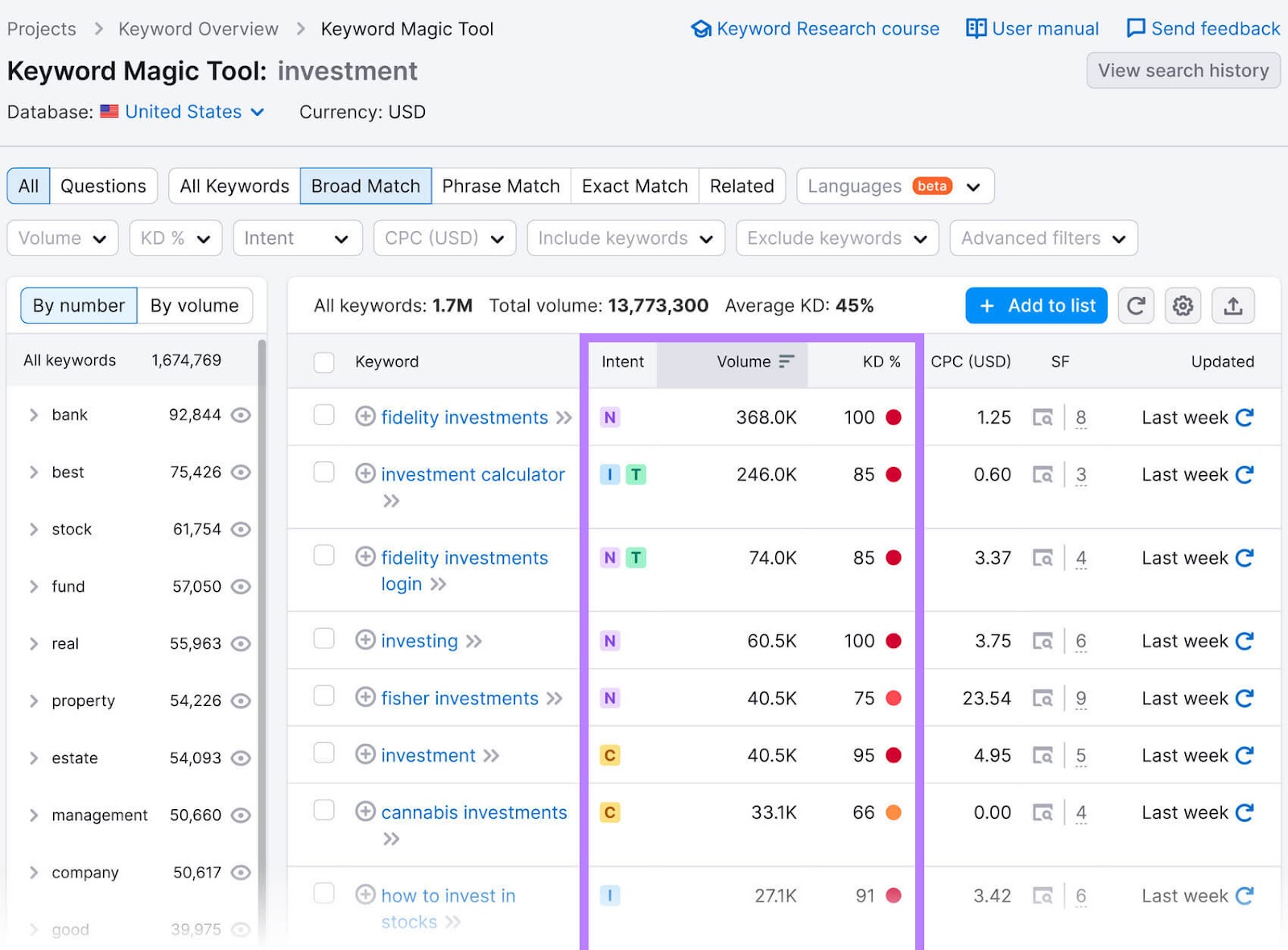
Once you’ve chosen keywords and implemented them into your site and content, use the Position Tracking tool to see how your site ranks in Bing’s SERPs and AI-generated results.
Simply navigate to Position Tracking and set Bing as your search engine when configuring your campaign.
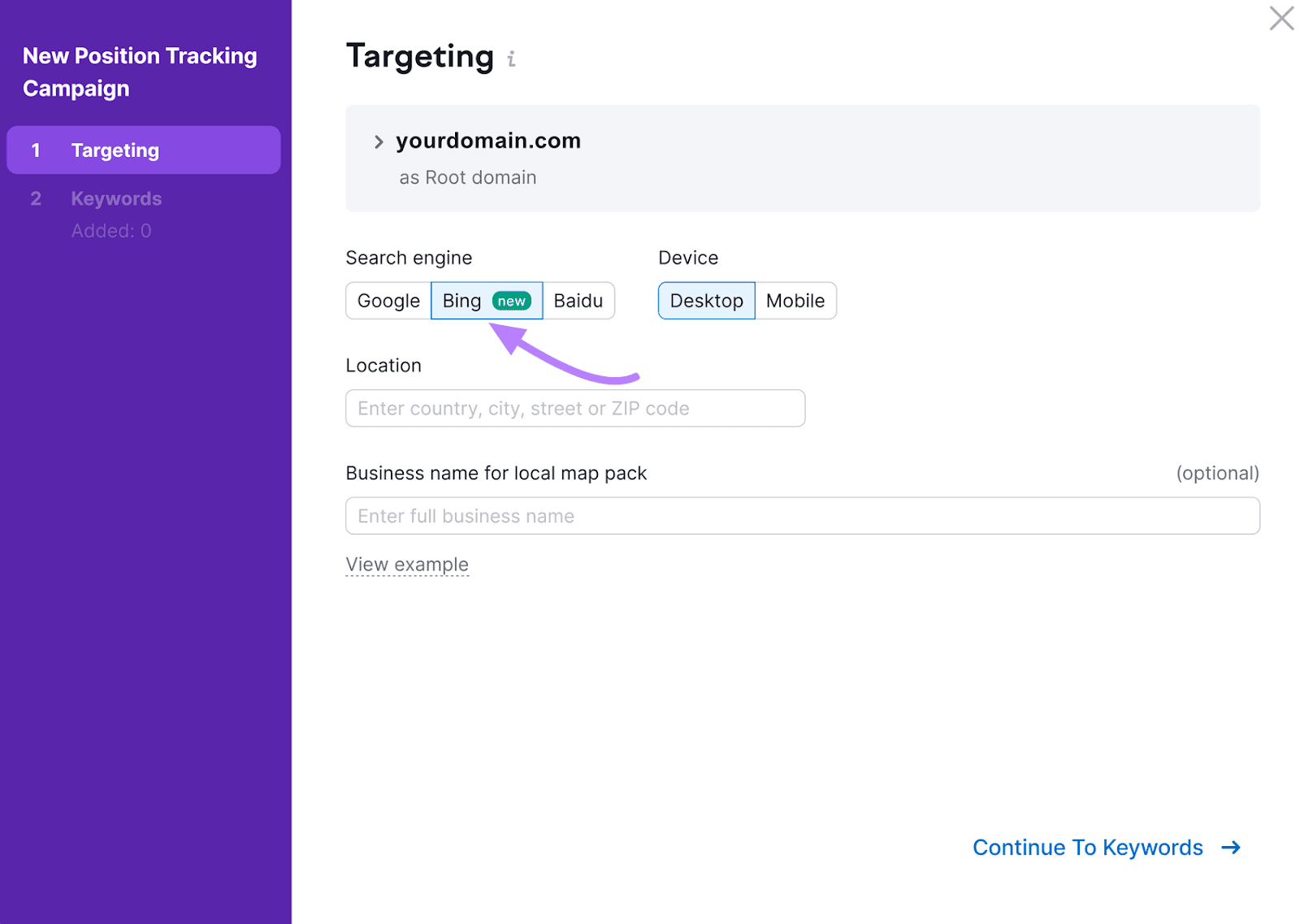
Once the tool starts collecting data, you’ll be able to track your visibility and rankings from the reports.
Prioritize Quality Content
We’ve seen how Bing favors fresh, original content that satisfies search intent. In this respect, it’s no different from Google.
Your content should be well-written, logically structured, and offer the reader as much value as possible. Fluff pieces and rehashed articles won’t cut it.
Add relevant and engaging multimedia content to your pages wherever it makes sense. Adding alt text to your images (a short description of the image) and captions and subtitles to your videos improves accessibility and makes it easier for Bing to interpret your content accurately.
Boost Social Signals
Increasing your social media presence and encouraging your audience to engage with and share your content could improve your Bing search rankings.
Earn Backlinks from Reputable Sites
Building high-quality backlinks from relevant and authoritative sources is essential for establishing your site’s credibility.
Some effective link-building strategies include guest posting, claiming broken links (asking website owners to replace non-working links to other sites with a relevant link to your site), and creating highly linkable content featuring primary research.
Claim Your Business on Bing Places
Listing your company on Bing Places for Business will boost your visibility for local searches and ensure your business information is accurately represented in Bing’s search results.
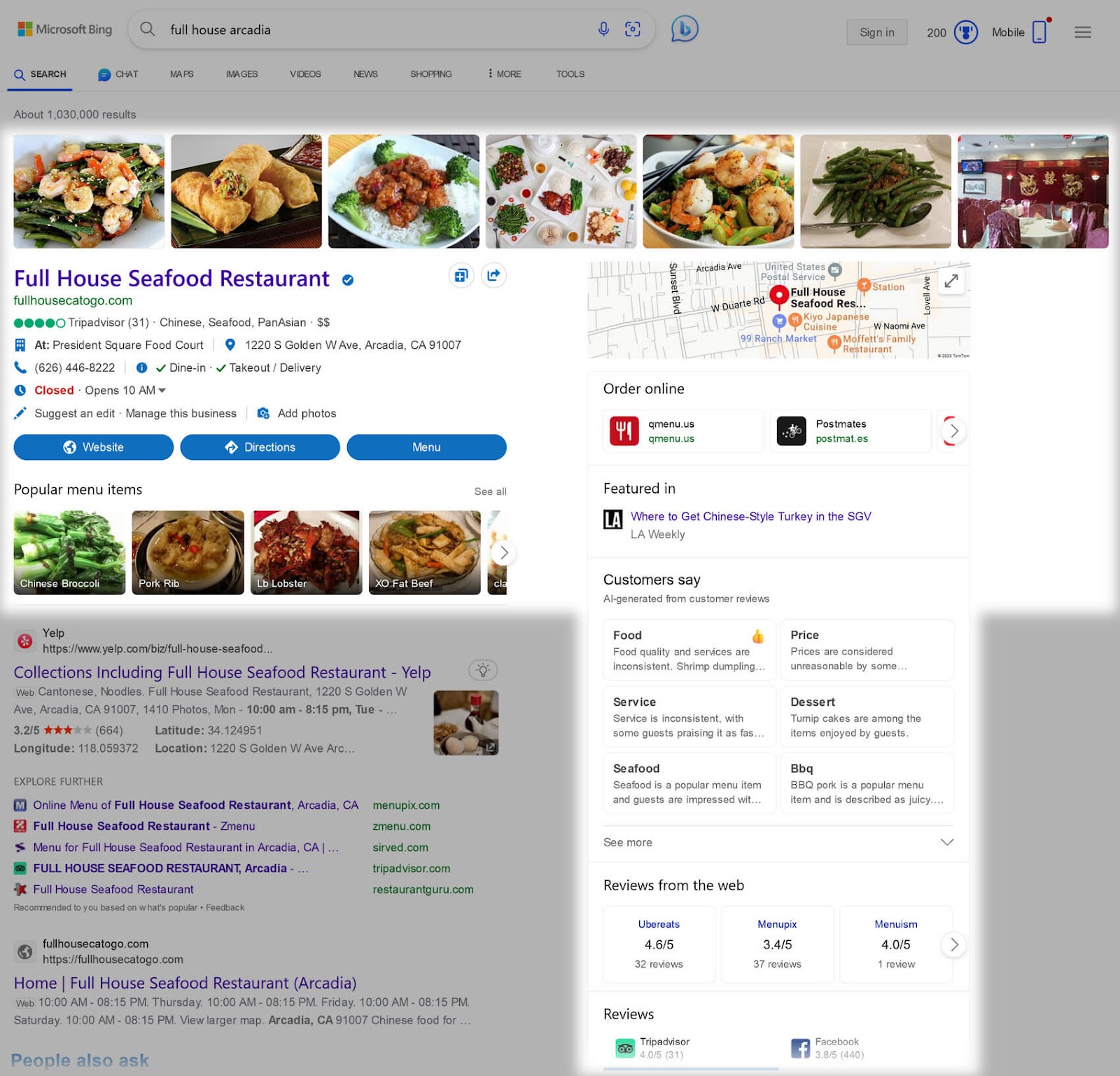
Increase the appeal of your listing by adding high-quality photos and detailed descriptions about your business and encouraging customers to leave reviews.
Improve Technical SEO
Ensuring that technical aspects of your site are up to scratch makes it easier for Bing to crawl and index your site and provides visitors with a better user experience.
Page load speed, mobile responsiveness, clear navigation, and schema markup (web code that helps search engines categorize your content) each play a central role in your site’s overall performance.
Leverage Bing Webmaster Tools
Bing Webmaster Tools provides tons of insights into how your site performs in the search engine.
This free SEO toolkit—comparable to Google Search Console—lets you understand traffic patterns, identify keywords driving traffic to your site, and diagnose technical issues.
Using Bing for Digital Marketing
In addition to SEO, Bing offers a range of PPC advertising opportunities through Microsoft Advertising (formerly Bing Ads). The platform lets businesses create and display ads in Bing’s search results and other Microsoft-owned sites.
While Microsoft Advertising has much in common with its Google counterpart, advertising on Bing comes with some distinct advantages.
First, the competition isn’t as fierce, which means you could potentially win better ad placements for less money.
But an equally important benefit is that Microsoft Ads offers comprehensive and unique targeting options, including the ability to target audiences based on information pulled from LinkedIn.
This makes Bing ads a powerful tool for B2B marketers looking to reach professionals and decision-makers within specific industries.
Improve Your Bing SEO Rankings with Semrush
While Bing may not be the biggest player in the search engine arena, there’s no doubt it offers businesses a unique and effective way to amplify their online presence.
The search engine has implemented several innovations during its 15-year history, culminating with its new AI-powered search offering that has yet to be matched by Google on a global scale.
Many businesses overlook Bing search in their SEO and digital marketing efforts. But you should view this as a strategic advantage.
By applying the insights mentioned above and adopting tools like Position Tracking, Keyword Magic, and Backlink Analytics, you can improve your rankings on Bing search.
This post was updated in 2024. Excerpts from the original article by Chima Mmeje may remain.
